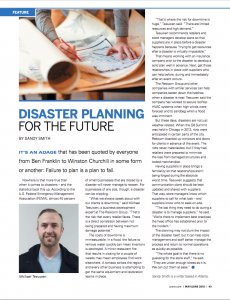
The Resicom Group Shares Proven Strategies for Disaster Preparedness in the Current Issue of PRSM Magazine
It’s an adage that has been quoted by everyone from Ben Franklin to Winston Churchill in some form or another: Failure to plan is a plan to fail.
Nowhere is that more true than when it comes to disasters – and the statistics back this up. According to the U.S. Federal Emergency Management Association (FEMA), almost 40 percent of small businesses that are closed by a disaster will never manage to reopen. For businesses of any size, though, a disaster can be crippling.

“What we always speak about with our clients is downtime,” said Michael Teeuwen, a business development expert at The Resicom Group. “That’s the risk that every retailer faces. There is a direct correlation between not being prepared and having maximum damage potential.”
The costs of downtime is immeasurable. In a flood, the failure to remove water quickly can mean inventory is destroyed. A minor restaurant fire
that results in closing for a couple of weeks may mean employees find work elsewhere. A tornado strikes the region and every other business is attempting to get the same equipment and restoration teams in place.
“That’s where the risk for downtime is huge,” Teeuwen said. “There are limited resources and high demand.”
Teeuwen recommends retailers and store managers develop plans so that suppliers are in place before a disaster happens because “trying to get resources after a disaster is virtually impossible.”
That means working with an insurance company prior to the disaster to develop a solid plan well in advance. Next, get those relationships in place with suppliers who can help before, during and immediately after an event occurs.
The Resicom Group and other companies with similar services can help companies batten down the hatches when a disaster is near. Teeuwen said the company has worked to secure rooftop HVAC systems when high winds were forecast and to sandbag when a flood was imminent.
But these days, disasters are not just weather-related. When the G8 Summit was held in Chicago in 2012, riots were anticipated in certain parts of the city. Resicom boarded up windows and doors for clients in advance of the event. The riots never materialized, but if they had, retailers were prepared to minimize the loss from damaged structures and looted merchandise.
Having suppliers in place brings a familiarity so that relationships aren’t being forged during the absolute worst time. Teeuwen suggests that communication plans should be kept updated and shared with suppliers. That way, store managers know which suppliers to call for what task – and suppliers know who to seek on-site.
“The last thing they need to do during a disaster is to manage suppliers,” he said. “We’re there to implement best practices the head office has established prior to the incident.”
The planning may not blunt the impact of the disaster itself, but it can help store management and staff better manage the process and return to normal operations as quickly as possible.
“The whole goal is that there is no guessing for the store staff,” he said. “They are under enough stress as it is. We can put them at ease.”
This Article was featured in PRSM Magazine’s May/June 2016 Issue and features commentary by our Client Advocate Michael Teeuwen of The Resicom Group.
Click Here or the Image Below for a PDF of the Article
Disaster Planning for the Future by Sandy Smith.
Sandy Smith is a writer based in Atlanta.

